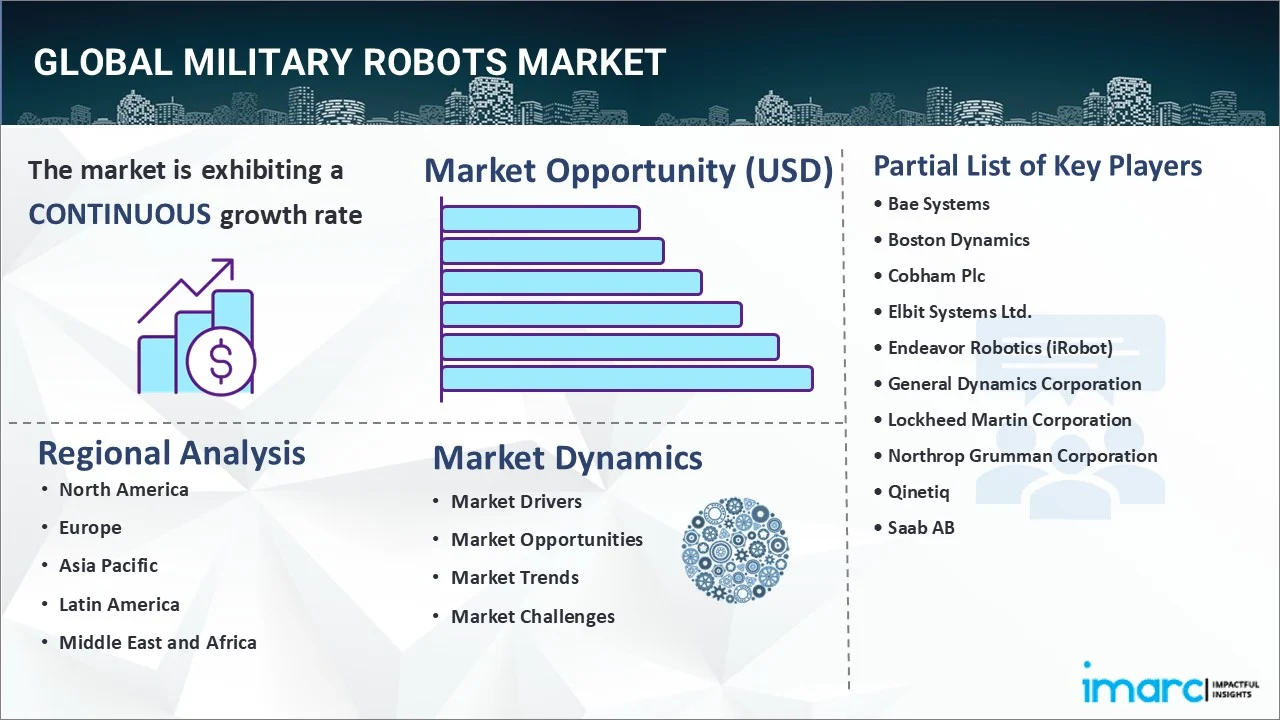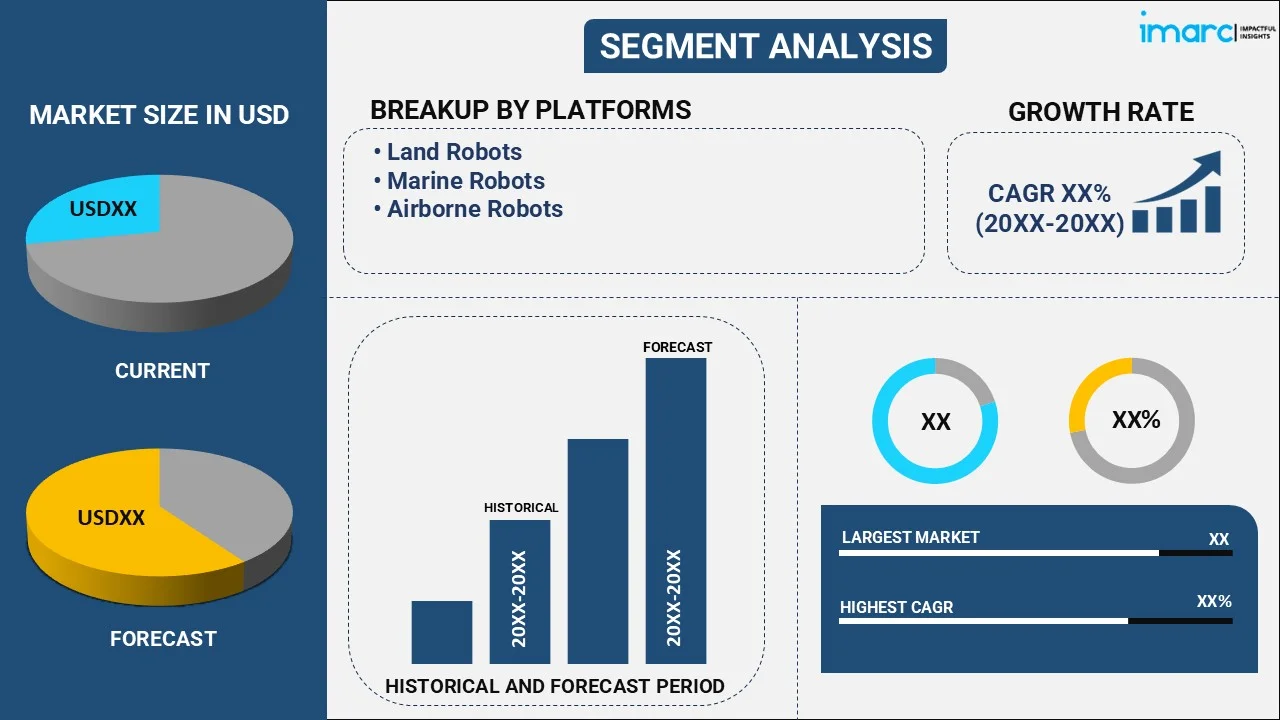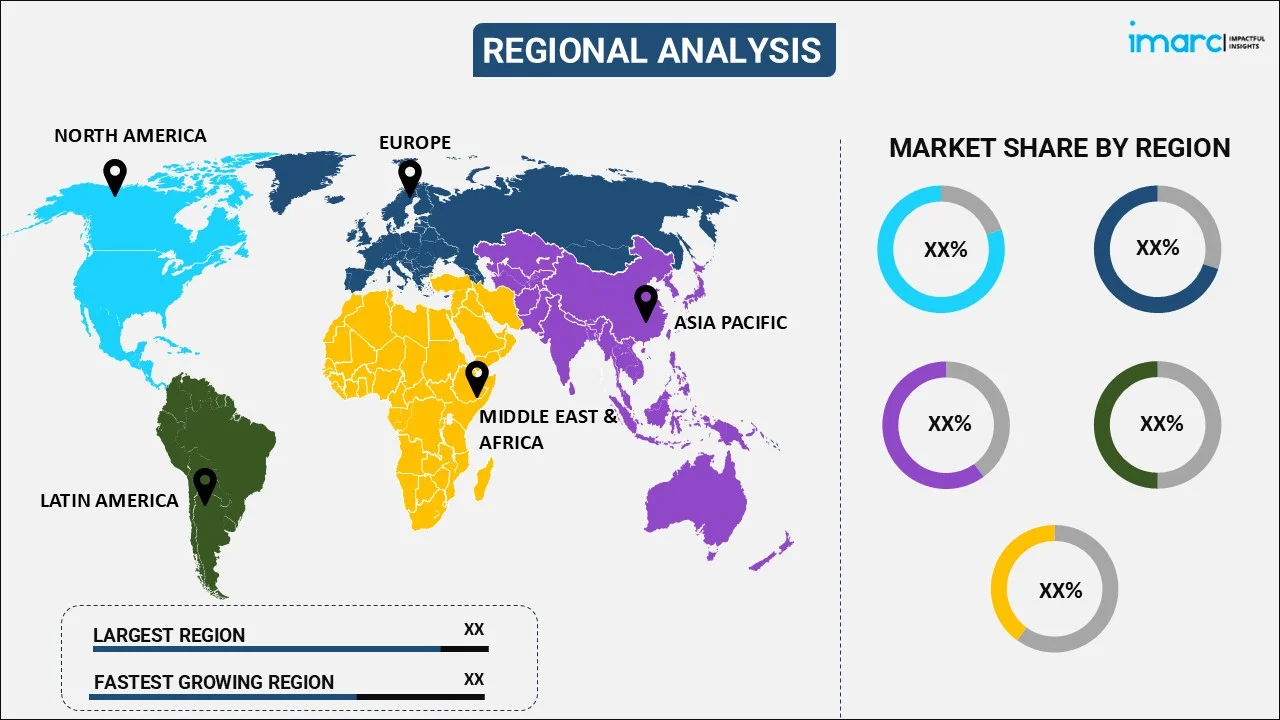
Military Robots Market Report by Platform (Land Robots, Marine Robots, Airborne Robots), Application (Intelligence, Surveillance and Reconnaissance (ISR), Search and Rescue, Combat Support, Transportation, EOD, Mine Clearance, Firefighting, and Others), Mode of Operation (Human Operated, Autonomous), and Region 2025-2033
Market Overview 2025-2033:
The global military robots market size reached USD 21.1 Billion in 2024. Looking forward, IMARC Group expects the market to reach USD 48.1 Billion by 2033, exhibiting a growth rate (CAGR) of 9.6% during 2025-2033.
|
Report Attribute
|
Key Statistics
|
|---|---|
|
Base Year
|
2024
|
|
Forecast Years
|
2025-2033
|
|
Historical Years
|
2019-2024
|
|
Market Size in 2024
|
USD 21.1 Billion |
|
Market Forecast in 2033
|
USD 48.1 Billion |
| Market Growth Rate 2025-2033 | 9.6% |
A military robot refers to a human-operated or automated mechanical device that is used for Intelligence, Surveillance and Reconnaissance (ISR) activities on land, water and air. The robots are specifically configured for military functions and are equipped with global positioning systems (GPS), Light Detection and Ranging (LIDAR) systems and fiber optics tethers to transform, receive and forward information to various endpoints. They are also used for operations involving search and rescue, combat support, transportation, mine clearance and firefighting. Some of the commonly used military robots, such as Unmanned Security Vehicles (USVs), are equipped with sensors, video and thermal cameras, microphones and two-way radios. They provide backup against heavy artillery and can also be used to rescue injured soldiers or troops from the battlefield.

Military Robots Market Trends:
The market is primarily being driven by an alarming increase in terrorism across the globe. In line with this, the growing requirement for efficient military robots that can perform hazardous tasks and can be deployed in life-threatening situations to minimize the casualties of soldiers is further facilitating the demand for military robots. Significant advancements in robotics and automation technologies are acting as another major growth-inducing factor. For instance, the integration of artificial intelligence (AI) has enabled the production of military robots with advanced monitoring, targeting and information gathering systems.
Governments of both emerging and developed nations are investing significantly to improve their existing security infrastructure. Initiatives are continually being undertaken to equip air, marine and land forces with advanced security solutions, such as wheeled, tracked and legged robots, wearable robots, Remotely Operated Underwater Vehicles (ROVs) and Unmanned Combat Aerial Vehicle (UCAV). Other factors, including increasing investments in the defense sector and the implementation of various military modernization programs, are projected to drive the market in the coming years.
Key Market Segmentation:
IMARC Group provides an analysis of the key trends in each sub-segment of the global military robots market report, along with forecasts at the global, regional and country level from 2025-2033. Our report has categorized the market based on platform, application and mode of operation.
Breakup by Platform:

- Land Robots
- Wheeled
- Tracked
- Legged
- Wearable
- Marine Robots
- Unmanned Surface Vehicles (USVs)
- Autonomous Underwater Vehicles (AUVs)
- Remotely Operated Underwater Vehicles (ROVs)
- Airborne Robots
- Small UAV
- Strategic UAV
- Tactical UAV
- Unmanned Combat Aerial Vehicle (UCAV)
Breakup by Application:
- Intelligence, Surveillance and Reconnaissance (ISR)
- Search and Rescue
- Combat Support
- Transportation
- EOD
- Mine Clearance
- Firefighting
- Others
Breakup by Mode of Operation:
- Human Operated
- Autonomous
Breakup by Region:

- North America
- United States
- Canada
- Asia Pacific
- China
- Japan
- India
- South Korea
- Australia
- Indonesia
- Others
- Europe
- Germany
- France
- United Kingdom
- Italy
- Spain
- Russia
- Others
- Latin America
- Brazil
- Mexico
- Others
- Middle East and Africa
Competitive Landscape:
The competitive landscape of the industry has also been examined with some of the key players being Bae Systems, Boston Dynamics, Cobham Plc, Elbit Systems Ltd., Endeavor Robotics (iRobot), General Dynamics Corporation, Lockheed Martin Corporation, Northrop Grumman Corporation, Qinetiq, Saab AB, etc.
Report Coverage:
| Report Features | Details |
|---|---|
| Base Year of the Analysis | 2024 |
| Historical Period | 2019-2024 |
| Forecast Period | 2025-2033 |
| Units | Billion USD |
| Segment Coverage | Platform, Application, Mode of Operation, Region |
| Region Covered | Asia Pacific, Europe, North America, Latin America, Middle East and Africa |
| Countries Covered | United States, Canada, Germany, France, United Kingdom, Italy, Spain, Russia, China, Japan, India, South Korea, Australia, Indonesia, Brazil, Mexico |
| Companies Covered | Bae Systems, Boston Dynamics, Cobham Plc, Elbit Systems Ltd., Endeavor Robotics (iRobot), General Dynamics Corporation, Lockheed Martin Corporation, Northrop Grumman Corporation, Qinetiq and Saab AB |
| Customization Scope | 10% Free Customization |
| Post-Sale Analyst Support | 10-12 Weeks |
| Delivery Format | PDF and Excel through Email (We can also provide the editable version of the report in PPT/Word format on special request) |
Key Questions Answered in This Report
The global military robots market was valued at USD 21.1 Billion in 2024.
We expect the global military robots market to exhibit a CAGR of 9.6% during 2025-2033.
The rising integration of military robots with advanced monitoring, targeting, and information gathering systems, that can be deployed in life-threatening situations to minimize casualties, is primarily driving the global military robots market.
The sudden outbreak of the COVID-19 pandemic had led to the had led to the implementation of stringent lockdown regulations across several nations resulting in the temporary closure of numerous manufacturing units for military robots.
Based on the platform, the global military robots market can be segmented into land robots, marine robots, airborne robots. Currently, airborne robots hold the majority of the total market share.
Based on the application, the global military robots market has been divided into Intelligence, Surveillance and Reconnaissance (ISR), search and rescue, combat support, transportation, EOD, mine clearance, firefighting, and others. Among these, Intelligence, Surveillance and Reconnaissance (ISR) currently exhibits a clear dominance in the market.
Based on the mode of operation, the global military robots market can be categorized into human operated and autonomous. Currently, human operated accounts for the largest market share.
On a regional level, the market has been classified into North America, Asia Pacific, Europe, Latin America, and Middle East and Africa, where North America currently dominates the global market.
Some of the major players in the global military robots market include Bae Systems, Boston Dynamics, Cobham Plc, Elbit Systems Ltd., Endeavor Robotics (iRobot), General Dynamics Corporation, Lockheed Martin Corporation, Northrop Grumman Corporation, Qinetiq, Saab AB, etc.
Need more help?
- Speak to our experienced analysts for insights on the current market scenarios.
- Include additional segments and countries to customize the report as per your requirement.
- Gain an unparalleled competitive advantage in your domain by understanding how to utilize the report and positively impacting your operations and revenue.
- For further assistance, please connect with our analysts.
 Request Customization
Request Customization
 Speak to an Analyst
Speak to an Analyst
 Request Brochure
Request Brochure
 Inquire Before Buying
Inquire Before Buying




.webp)




.webp)












